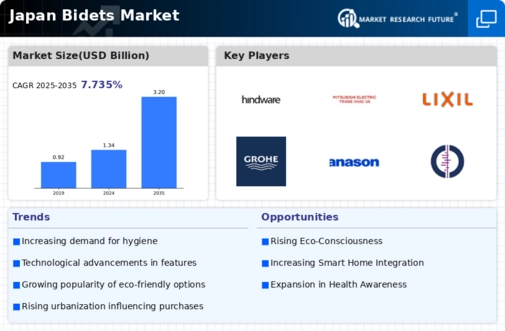The Japan Bidets Market has shown significant growth over recent years, driven by the increasing awareness of hygiene and comfort among consumers. With a rich cultural emphasis on cleanliness and advanced technological integration in bathroom fixtures, Japan represents a sophisticated market with diverse customer preferences. The competitive landscape is characterized by a mix of established players and emerging brands, each striving to capture a share of the market through innovative designs, superior features, and effective marketing strategies.
As consumer demand for advanced bidet systems continues to rise, manufacturers are focusing on product differentiation, enhancing user experience, and utilizing advanced technologies to stay ahead in this dynamic marketplace. This competitive analysis provides insights into the strengths and market positioning of key players in the Japan Bidets Market. Hindware has established a notable presence in the Japan Bidets Market, leveraging its reputation for quality and functionality. The company is recognized for its commitment to manufacturing advanced bathroom solutions that align with modern consumer needs.
One of Hindware's significant strengths lies in its innovative approach to product design, which combines aesthetics with practicality. By creating bidet products that integrate seamlessly into various bathroom styles, Hindware has succeeded in attracting a discerning customer base. Additionally, the brand's keen focus on sustainability and efficient water usage resonates well with environmentally conscious consumers in Japan. The continuous development of new features and enhancements in bidet technology further reinforces Hindware's competitive edge, solidifying its strategic position within the market. Mitsubishi Electric is a key player in the Japan Bidets Market, known for its cutting-edge technology and commitment to quality.
The company has a strong portfolio of products, including a range of technologically advanced bidet systems that cater to the preferences of Japanese consumers. Mitsubishi Electric emphasizes innovation in its product offerings, featuring smart functions that enhance user convenience, such as heated seats, adjustable nozzles, and energy-saving modes. The company's strengths lie in its robust research and development capabilities, enabling it to introduce pioneering features consistently. Mitsubishi Electric has also engaged in strategic partnerships and collaborations, enhancing its market reach and capabilities.
Its focus on sustainability and energy efficiency aligns with the increasing consumer demand for eco-friendly solutions, positioning Mitsubishi Electric favorably in a competitive market landscape. Through ongoing investments in technology and customer-centric designs, Mitsubishi Electric continues to maintain a strong foothold in the Japan Bidets Market while addressing evolving consumer needs.
























Leave a Comment